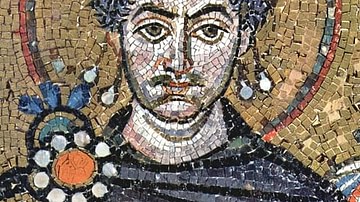Review

| Rating: | |
|---|---|
| Title: | Decorated Roman Armour: From the Age of the Kings to the Death of Justinian the Great |
| Author: | Raffaele D'Amato & Andrey Evgenevich Negin |
| Audience: | Professional |
| Difficulty: | Hard |
| Publisher: | Frontline Books |
| Published: | 2017 |
| Pages: | 689 |
In Decorated Roman Armour: From the Age of the Kings to the Death of Justinian the Great, Raffaele D’Amato and Andrey Evgenevich Negin provide a chronological and typological analysis of Roman army equipment, especially focusing on “the evolution of decorated armour throughout the history of ancient Rome” (xv). Unfortunately, the book is only accessible to Roman specialists on account of the extensive use of technical terminology.
In Decorated Roman Armour: From the Age of the Kings to the Death of Justinian the Great, Raffaele D'Amato and Andrey Evgenevich Negin provide a chronological and typological analysis of Roman army equipment, especially focusing on “the evolution of decorated armour throughout the history of ancient Rome” (xv). Raffaelle D'Amato has published extensively on the subject of the Roman military. Andrey Negin is a scholar based in Lobachevsky State University of Nizhni Novgorod (Russia). He has published extensively on the subjects of Roman armour through a variety of publishers and academic journals, both in English and Russian. Simply put, both authors have the necessary background and qualifications for publishing a book on Roman armour.
The book is divided into five chapters, distinguished by time period and with one chapter expanding on the archaeological context from 27 BCE – 284 CE (753-509 BCE; 509-27 BCE; 27 BCE – 284 CE; and 284-565 CE). To analyze armor in these time periods, they focus on three aspects: individual pieces, iconography (such as artwork with images of Roman soldiers), and representation in written sources. Moreover, each chapter contains engaging and vivid illustrations. Illustrations include both pictures of artifacts and drawings of artifacts by Andrey Evgenevich Negin. They are thorough and comprehensive, engaging with how other scholars interpret Roman armor and disagreeing, agreeing, or supplementing new information when necessary.
As far as I am aware, the volume accomplishes the goal of communicating a history of decorated Roman armor. Yet, an important caveat must be noted: it only effectively communicates a history of decorated Roman armor to specialists. Although the book describes itself as “essential reading for any Roman military enthusiast” and helping the reader “to see the history of decorated armour throughout the whole history of Ancient Rome” (xv), it cannot be digested, or frankly understood, without extensive previous experience and understanding of technical terminology regarding armor types, chronological distinctions, social/military classes, and culture and society, each of which are often referenced with Latin or Greek terms. As I noted for myself within 15 pages of reading the book, “I have to have Google open in order to read this book and understand it!”
There are two potential solutions to this problem, solutions which would make accessible a dense work full of technical terminology. First, a glossary of technical terms at the end of the book would be helpful. Second, even if the authors didn't include a glossary, summaries of each chapter should have been provided. Moreover, this should have been reinforced with a chapter called “Conclusions” at the end of the volume. Such an inclusion would have made clearer to specialists and a general audience the ideas presented by D'Amato and Negin.
In summary, Decorated Roman Armour is written by decorated scholars of Roman armour, Raffaele D'Amato and Andrey Evgenevich Negin. That is to say, much of the discussion in the volume will help to move forward our understanding of the function of Roman armour throughout history. Even so, much of it is inaccessible to anybody other than specialists because it assumes the reader understands the dense technical terminology. Moreover, they do nothing to mitigate or solve this problem, such as a glossary or simplified summaries of each chapter. So, while I suspect this volume would be helpful to scholars of the ancient Rome or military history, it is inaccessible to even the Roman military enthusiast. Therefore, I recommend this book for scholarship purposes; however, it is not helpful to the enthusiast or general audience for getting a sense of the history of decorated Roman armour.
About the Reviewer
Cite This Work
APA Style
Brown, W. (2018, November 06). Decorated Roman Armour: From the Age of the Kings to the Death of Justinian the Great. World History Encyclopedia. Retrieved from https://www.worldhistory.org/review/196/decorated-roman-armour-from-the-age-of-the-kings-t/
Chicago Style
Brown, William. "Decorated Roman Armour: From the Age of the Kings to the Death of Justinian the Great." World History Encyclopedia. Last modified November 06, 2018. https://www.worldhistory.org/review/196/decorated-roman-armour-from-the-age-of-the-kings-t/.
MLA Style
Brown, William. "Decorated Roman Armour: From the Age of the Kings to the Death of Justinian the Great." World History Encyclopedia. World History Encyclopedia, 06 Nov 2018, https://www.worldhistory.org/review/196/decorated-roman-armour-from-the-age-of-the-kings-t/. Web. 27 Apr 2025.




